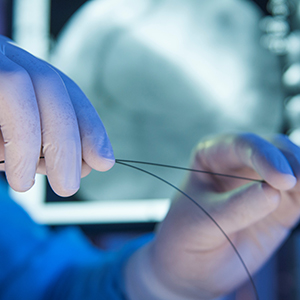Biomedical Morphology
Home » Biomedical Morphology
EAG Laboratories investigates biomedical morphology and microstructures through imaging analysis. In its simplest form, imaging analysis is looking at a surface using microscopy (either optical or electron). The information provided is limited by the capabilities of the instrumentation used. The primary analytical technique employed in this type of analysis is Scanning Electron Microscopy (SEM) and Transmission Electron Microscopy (TEM).
Scanning Electron Microscopy (SEM) provides high-resolution and long-depth-of-field images of the sample surface and near-surface. SEM is one of the most widely used analytical tools due to the extremely detailed images it can quickly provide. Coupled to an auxiliary Energy Dispersive X-ray Spectroscopy (EDS) detector, SEM also offers elemental identification of nearly the entire periodic table.
EAG Laboratories uses SEM analysis in cases where optical microscopy cannot provide sufficient image resolution or high enough magnification.

Biomedical Morphology Applications
Applications include failure analysis, dimensional analysis, process characterization, reverse engineering, and particle identification. EAG’s expertise and range of experience is invaluable to the medical device and diagnostic companies. Person-to-person service ensures good communication of the results and their implications. Customers are often present during the analysis, enabling an immediate sharing of data, imaging and information.
Transmission Electron Microscopy (TEM) and Scanning Transmission Electron Microscopy (STEM) are closely related techniques that use an electron beam to image a sample. High energy electrons, incident on ultra-thin samples allow for image resolutions that are on the order of 1-2Å. Compared to SEM, TEM and STEM have better spatial resolution and are capable of additional analytical measurements, but require significantly more sample preparation.
Although more time consuming than many other common analytical tools, the wealth of information TEM and STEM analyses is impressive. Not only can outstanding image resolution be obtained, it is also possible to characterize crystallographic phase, crystallographic orientation (by diffraction mode experiments), produce elemental maps (using EDS or EELS), and obtain images that highlight elemental contrast (dark field mode). These can all be done from nm sized areas that can be precisely located. STEM and TEM are the ultimate failure analysis tools for thin film and IC samples.
The lateral distribution (i.e. location) of elemental, inorganic or molecular species can be investigated using:
- Electron beam techniques: (SEM, Energy Dispersive X-ray Spectroscopy and Auger Electron Spectroscopy)
- Ion beam techniques: (Time-of-Flight Secondary Ion Mass Spectrometry and Focused Ion Beam)
These methods provide maps or images that show the relative positions of different species of interest, giving useful information regarding features, defects, particles, etc..
Other techniques can also be used to obtain images:
- Raman Spectroscopy typically measures molecular vibrations and provides information on functional groups, types of carbon, and stress/strain.
- Atomic Force Microscopy (AFM) provides surface roughness images and also hardness, and magnetic property images.
- X-ray Photoelectron Spectroscopy (XPS) provides elemental and chemical maps.
- Optical Profilometry (OP) can generate 3 dimensional images of surfaces, for dimensional measurement or imaging of specific features.
Would you like to learn more about Biomedical Morphology?
Contact us today for your Biomedical Morphology needs. Please complete the form below to have an EAG expert contact you.